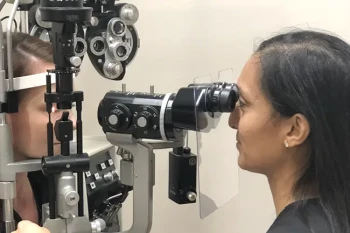
Regular readers of this blog know that cataracts are a clouding of the eye’s natural lens that can create a number of visual impediments. But did you know there are multiple types of cataracts, which have distinct causes, appearances, and effects?
Nuclear cataracts
These are the most common cataracts. The center of the lens, or nucleus, starts to harden and turn yellow, eventually spreading from there. This can result in difficulty seeing in areas with poor light and can make driving difficult. Some people find their near vision improves temporarily, because the eye’s ability to focus changes.
Cortical cataracts
These cataracts form from the outside edge of the lens and grow inward. These cataracts scatter light, causing glare and halos, especially when driving at night or in the rain. They can cause issues with both near and distance vision. Diabetic patients are particularly at risk for these.
Posterior subcapsular cataracts

These cataracts form on the back surface of the lens. People with these cataracts may notice halos or glares around lights, or even a smudge over their vision, CEENTA Ophthalmologist Nikki Saraiya, MD, said. They develop faster than other types of cataracts and are often seen in diabetic patients or those who take oral steroids.
Congenital cataracts
While most cataracts affect people as they age, there are cases when some babies are born with them. This can be due to genetic issues or illnesses the mother had when pregnant. They only need to be removed if they are blocking the baby’s vision, leading to amblyopia.
Radiation cataracts
UV rays from the sun can be a significant cause of cataracts. People who spend a lot of time outside, or who have received radiation treatment for cancer, could develop cataracts as a result.
Traumatic cataracts
While in most cases cataracts are caused by factors such as aging or the absorption of UV rays, cataracts can also be caused by an injury to the eye. These injuries can include blunt or sharp trauma, Dr. Saraiya said.
Cataract care for you
Remember, no matter what type of cataract you have, the cataract surgeons at CEENTA are here to care for your unique needs.
This blog is for informational purposes only. For specific medical questions, please consult your physician. Dr. Saraiya practices in our SouthPark, Matthews, and Pineville offices. To make an appointment with her or a CEENTA eye doctor near you, call 704-295-3000. You can also schedule an appointment online or through myCEENTAchart.
You may also be interested in

Cataracts have more symptoms than just a milky-white appearance. Learn more about some of the lesser-known symptoms of cataracts with cataract surgeon Allison Baker, MD.

Beyond cataract removal, find out if cataract surgery can help with nearsightedness, farsightedness, astigmatism, and night blindness.

After your cataract surgery, follow these post-op steps to ensure that you can see clearly.
Comments
October 13, 2020
Leave a Comment
Back to News


October 11, 2020